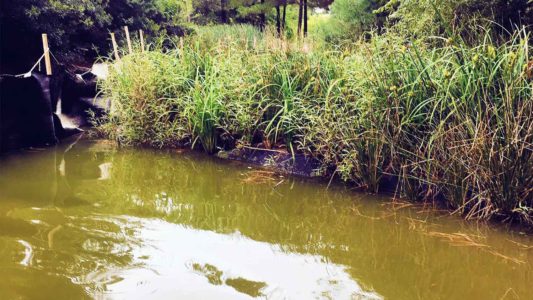These Floating Islands May Improve Water Quality

Dani Winter loves when it rains on campus.
For someone researching stormwater, more rain equals more data. More data equals more answers.
Since last summer, Winter and fellow NC State student Bryan Maxwell have been using an on-campus research site to evaluate whether floating islands of plants can improve stormwater quality.
“We are looking at floating islands as a water quality tool,” said Maxwell, a Ph.D. student in biological and agricultural engineering. “The roots from the plants hang down in the water and help clean the water. They’re like a filter.”

With grants from the Water Resources Research Institute at NC State and the NC State Sustainability Fund, Maxwell and Winter designed, built and installed floating islands in two campus stormwater ponds in 2017.
Near Wolf Village Apartments, they turned a stormwater pond into a living lab. A temporary vinyl barrier divides the pond into a control side and an experimental side, which holds several floating islands of wetland plants native to North Carolina.
Working with associate professor Francois Birgand, the students measure levels of nitrogen, phosphorus and suspended solids, which are small particles that contribute to lower water quality. Cutting-edge water quality sensors provide continuous, multi-point data as water enters and exits the pond.
“We’re monitoring water quality in the pond over a spatial gradient all the time,” said Winter, a senior majoring in biological and agricultural engineering. “This is the first time that we know of that this technology has been used in stormwater.”
While the water quality data won’t be completed until August, the islands have already become a habitat for animals, reptiles, amphibians, insects and microbes.
“The islands breed a lot of biodiversity,” said Winter, a Park Scholar who has conducted additional microbial research on the islands.

More floating islands are installed in a large stormwater pond near Engineering Building III on Centennial Campus. There, Maxwell and Winter experimented with different construction methods before deciding on 5’ by 8’ floating mats that hold about 40 plants and are anchored to the bottom of the pond.
After testing concludes in August and results are analyzed, the students hope floating islands become a popular addition to stormwater ponds, which are one of the state’s most commonly utilized management practices for stormwater.
“This project combines a pond with a island wetland,” Winter said. “It’s a retrofit to get more out of the ponds you already have.”
Follow the project on Twitter.